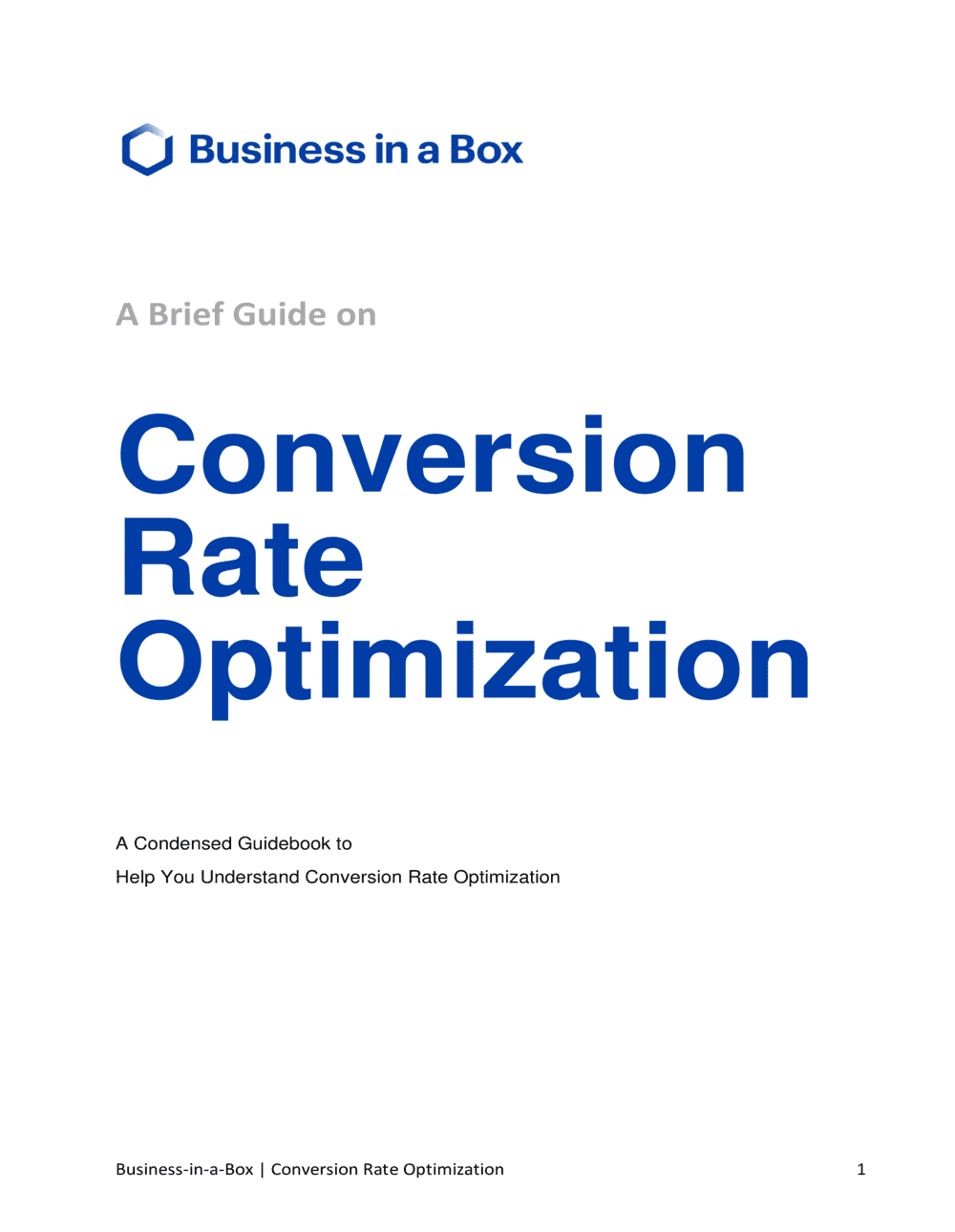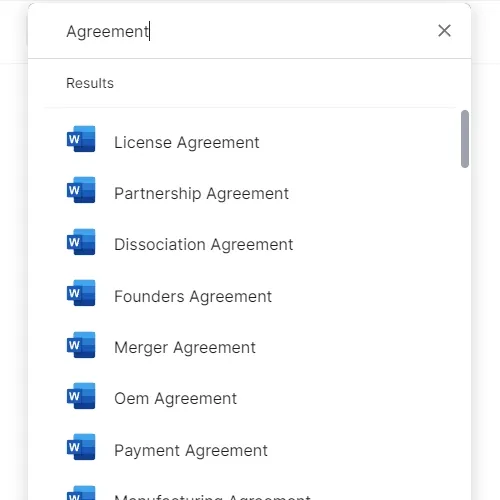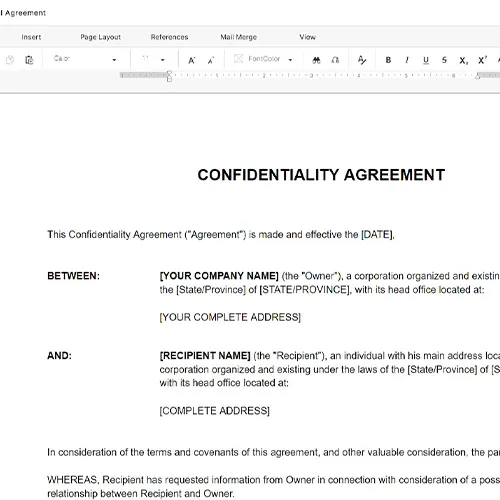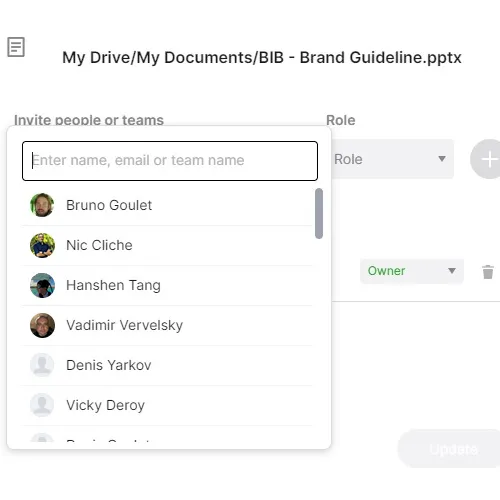Conversion Rate Optimization Template

Document content
This conversion rate optimization template has 11 pages and is a MS Word file type listed under our sales & marketing documents.
Sample of our conversion rate optimization template:
A Brief Guide on Conversion Rate Optimization A Condensed Guidebook to Help You Understand Conversion Rate Optimization Table of Contents Conversion Rate Optimization 3 What is a Conversion Rate? 3 What Does Conversion Rate Optimization Mean? 3 Why Do You Need Conversion Rate Optimization? 4 How to Increase Your Website Conversion Rate 6 Add Reviews, Logos, and Testimonials 6 Add a Live Chat to Your Site 6 Improve Your CTA Copy 6 Eliminate Page Distractions 7 A/B Test Your Website Headlines 7 Adding a Third-Party Registration Service 8 What are the Core Elements of CRO? 8 Landing Page Design 8 Page Speed 8 Forms 9 Site Structure and Navigation++ 9 Calls-to-Action (CTAs) 10 Website Copy 10 Final Thoughts 11 Conversion Rate Optimization In the 21st century, more businesses are moving online to take advantage of the increasing customer preference for digital platforms. However, to succeed in the online space, a company must successfully convert website visitors to potential clients. This ability to transform visitors to your page into potential customers depends on how well you understand them and give them what they need. Businesses with high website conversion rate optimization (CRO) win a significant online market share. Conversion rate optimization isn't as easy as you may think. However, understanding the critical basics can help you increase your conversion rate. New to CRO? If yes, this short guide will help you learn crucial CRO concepts, including best practices and why they're important. What is a Conversion Rate? The conversion rate is the proportion of website visitors who take the desired actions. You can calculate the website's conversion rate by dividing the number of converted visitors by the total number of visitors multiplied by 100. How to Calculate the Conversion Rate: (Conversions / Number of Visitors) x 100 = Conversion Rate What Does Conversion Rate Optimization Mean? CRO is the process of optimizing the percentage of visitors who perform the desired actions on your website. In this case, the desired actions may include signing up for a specific service, clicking a link, buying a product, or clicking the "add to cart" button. Modern-day online traffic is significantly inconsistent. Once you fail to get your website visitors into the conversion funnel in the first instance, this significantly minimizes the chances of them coming back and executing the desired action. Therefore, the best approach to improving your chances to win more conversions is running efficient CRO campaigns on your website. A lot occurs before a customer jumps into the final goal. You need to understand what happens before conversion so that you can build a successful CRO campaign. Those factors include: Specific drivers that bring visitors to the website Particular hooks that persuade visitors to convert Specific barriers that make them walk away Why Do You Need Conversion Rate Optimization? Conversion rate optimization is essential because it enables you to reduce the cost of acquiring customers. This is due to increased value from website visitors and existing users. Generally, it widens your customer base, enhancing business growth. For instance, suppose your current website has a 10% conversion rate and receives 3,000 visitors per month. In that case, it generates 300 conversions monthly. If you improve your website's conversion rate to 15% through various optimization strategies, your conversions will increase by 50% to 450 per month. Another advantage of conversion rate optimization is that it enhances the user experience (UX). It enables you to personalize UX for site visitors, providing exactly what the user needs. Also, you get better insight into the website visitors' behavior. The process of CRO starts by understanding your customers' behavior through various means, such as click maps and heatmaps. These tools provide vital information about which sections of the site visitors spend more time on. As a result, you can identify high conversion areas on the website and those that need improvement. There is no ideal CRO campaign. There is always room for improvement. Even successful companies such as Amazon and Netflix continually improve and iterate their websites and applications to better their users' experience, while growing their conversions. How to Increase Your Website Conversion Rate On average, website conversion rates are around 2%. Some websites even record a 0.1% conversion rate. Here are some key strategies used to increase website conversion rate. Add Reviews, Logos, and Testimonials Customers often look for reputable brands. Therefore, none of them wishes to be the first customer to purchase a specific service or product. You can ease the tension associated with acquiring new products by obtaining reviews and testimonials from other customers. Also, you can add logos of companies that have used your services to build customer trust instantly. As a result, website visitors are likely to become customers that develop confidence in your brand. Add a Live Chat to Your Site Many website visitors want to purchase your products or services but are unsure about various aspects. These doubts and questions may lead to conversion failure. The potential customers will prefer a competitor that offers a live chat service or they will physically visit a nearby store. Integrating live chatbots and tools can help these people. These tools are easy to integrate into the website and can significantly impact your conversion rate. Improve Your CTA Copy
Reviewed on

Document content
This conversion rate optimization template has 11 pages and is a MS Word file type listed under our sales & marketing documents.
Sample of our conversion rate optimization template:
A Brief Guide on Conversion Rate Optimization A Condensed Guidebook to Help You Understand Conversion Rate Optimization Table of Contents Conversion Rate Optimization 3 What is a Conversion Rate? 3 What Does Conversion Rate Optimization Mean? 3 Why Do You Need Conversion Rate Optimization? 4 How to Increase Your Website Conversion Rate 6 Add Reviews, Logos, and Testimonials 6 Add a Live Chat to Your Site 6 Improve Your CTA Copy 6 Eliminate Page Distractions 7 A/B Test Your Website Headlines 7 Adding a Third-Party Registration Service 8 What are the Core Elements of CRO? 8 Landing Page Design 8 Page Speed 8 Forms 9 Site Structure and Navigation++ 9 Calls-to-Action (CTAs) 10 Website Copy 10 Final Thoughts 11 Conversion Rate Optimization In the 21st century, more businesses are moving online to take advantage of the increasing customer preference for digital platforms. However, to succeed in the online space, a company must successfully convert website visitors to potential clients. This ability to transform visitors to your page into potential customers depends on how well you understand them and give them what they need. Businesses with high website conversion rate optimization (CRO) win a significant online market share. Conversion rate optimization isn't as easy as you may think. However, understanding the critical basics can help you increase your conversion rate. New to CRO? If yes, this short guide will help you learn crucial CRO concepts, including best practices and why they're important. What is a Conversion Rate? The conversion rate is the proportion of website visitors who take the desired actions. You can calculate the website's conversion rate by dividing the number of converted visitors by the total number of visitors multiplied by 100. How to Calculate the Conversion Rate: (Conversions / Number of Visitors) x 100 = Conversion Rate What Does Conversion Rate Optimization Mean? CRO is the process of optimizing the percentage of visitors who perform the desired actions on your website. In this case, the desired actions may include signing up for a specific service, clicking a link, buying a product, or clicking the "add to cart" button. Modern-day online traffic is significantly inconsistent. Once you fail to get your website visitors into the conversion funnel in the first instance, this significantly minimizes the chances of them coming back and executing the desired action. Therefore, the best approach to improving your chances to win more conversions is running efficient CRO campaigns on your website. A lot occurs before a customer jumps into the final goal. You need to understand what happens before conversion so that you can build a successful CRO campaign. Those factors include: Specific drivers that bring visitors to the website Particular hooks that persuade visitors to convert Specific barriers that make them walk away Why Do You Need Conversion Rate Optimization? Conversion rate optimization is essential because it enables you to reduce the cost of acquiring customers. This is due to increased value from website visitors and existing users. Generally, it widens your customer base, enhancing business growth. For instance, suppose your current website has a 10% conversion rate and receives 3,000 visitors per month. In that case, it generates 300 conversions monthly. If you improve your website's conversion rate to 15% through various optimization strategies, your conversions will increase by 50% to 450 per month. Another advantage of conversion rate optimization is that it enhances the user experience (UX). It enables you to personalize UX for site visitors, providing exactly what the user needs. Also, you get better insight into the website visitors' behavior. The process of CRO starts by understanding your customers' behavior through various means, such as click maps and heatmaps. These tools provide vital information about which sections of the site visitors spend more time on. As a result, you can identify high conversion areas on the website and those that need improvement. There is no ideal CRO campaign. There is always room for improvement. Even successful companies such as Amazon and Netflix continually improve and iterate their websites and applications to better their users' experience, while growing their conversions. How to Increase Your Website Conversion Rate On average, website conversion rates are around 2%. Some websites even record a 0.1% conversion rate. Here are some key strategies used to increase website conversion rate. Add Reviews, Logos, and Testimonials Customers often look for reputable brands. Therefore, none of them wishes to be the first customer to purchase a specific service or product. You can ease the tension associated with acquiring new products by obtaining reviews and testimonials from other customers. Also, you can add logos of companies that have used your services to build customer trust instantly. As a result, website visitors are likely to become customers that develop confidence in your brand. Add a Live Chat to Your Site Many website visitors want to purchase your products or services but are unsure about various aspects. These doubts and questions may lead to conversion failure. The potential customers will prefer a competitor that offers a live chat service or they will physically visit a nearby store. Integrating live chatbots and tools can help these people. These tools are easy to integrate into the website and can significantly impact your conversion rate. Improve Your CTA Copy
Easily Create Any Business Document You Need in Minutes.

Download or open template
Access over 3,000+ business and legal templates for any business task, project or initiative.

Edit and fill in the blanks
Customize your ready-made business document template and save it in the cloud.

Save, Share, Export, or Sign
Share your files and folders with your team. Create a space of seamless collaboration.



